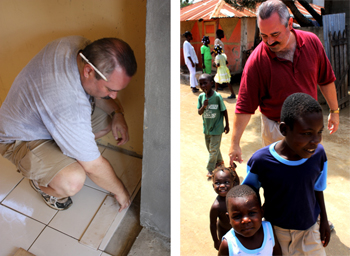
Joe Kranz of Turner Construction in HaitiNew York City architecture and construction firms are heading to Haiti in an effort to help rebuild the devastated Caribbean nation, which was hit with a magnitude 7 earthquake in January.
The interest from these firms comes as the international response is shifting from short-term assistance to long-term reconstruction. The process, which will likely mean rethinking the way the poverty-stricken country builds everything from homes to hospitals, could cost $14 billion, according to the Inter-American Development Bank, an organization that focuses on economic development in Latin America and the Caribbean. These New York firms plan to offer Haiti the latest technology so that more-secure buildings can rise out of the rubble.
As Dan Tishman of Tishman Construction told the New York Times shortly after the earthquake in January, how you rebuild is just as important as the effort itself. “When it comes time to rebuild, what are you going to be rebuilding?” he said.
Manhattan-based Turner Construction is among the companies whose employees have lent their expertise to help.
Turner has a history of aid work in Haiti. In 2009, project executive Joe Kranz traveled to Haiti with representatives from INOVA Fairfax Hospital in Virginia to renovate an outpatient care center in Pignon, a town about 80 miles outside the Haitian capital of Port-au-Prince, according to Chris McFadden, a spokesperson for Turner.
At that time, before the quake, the renovation included “an overhaul of the building exterior, a massive cleaning effort, fresh paint, new tile floors, new entry stairs and new electrical and plumbing systems,” McFadden explained. It was a volunteer effort.
This time, the mission was different. Kranz and another construction expert, Randy Friga, a volunteer coordinator with the Washington, D.C.-based Community Coalition for Haiti, returned to Pignon six days after the quake with a group of three medical volunteers from INOVA. The team flew into Santiago, Dominican Republic, and traveled by land to Pignon.
While the medical team provided treatment to earthquake victims, Kranz led the crew in completing the renovation effort he began a year earlier at the hospital, which has been flooded with refugees from Port-au-Prince.
Since the renovation, the outpatient center has roughly doubled in size, now 8,000 square feet total, and has the capacity to hold 90 patients, according to Karen Carr, the director of CCH. Today, the center includes an emergency room, an HIV/AIDS-specific center and a dorm for medical personnel.
The building was renovated using rebar and ultrasturdy cement — a relative rarity in Haiti, where many buildings are made of stones sealed with weak cement mix diluted with sand, so brittle that “you could hit it with a hammer and knock pieces of a wall out,” Carr said. This widespread structural deficiency is believed to have contributed to the scope of the disaster.
The team used equipment accumulated over years of volunteer work. Almost all the tools — including hammers and nails, paintbrushes and even a tile saw — were brought from the U.S. and left behind by past volunteers, Carr said.
Meanwhile, the Manhattan-based Beyer Blinder Belle Architects & Planners — whose high-profile projects include the restoration of the Chrysler Building’s interior, the Apollo Theater and the Beacon Theater — is planning its own mission to Haiti to help in the rebuilding effort, according to founding partner John Belle.
The firm is currently offering its skills pro bono from afar — including planning and design assistance to the World Monuments Fund, a New York City-based nonprofit that is planning a restoration effort in Haiti. Norma Barbacci, the program director for Latin America, Spain and Portugal at the World Monuments Fund, said the organization hopes to preserve the so-called gingerbread-style homes adjacent to the Port-au-Prince historic center.
Once the “first phase” of recovery is complete, Belle plans to travel to Haiti with a team to help design new and stronger structures to replace the flimsy homes and buildings that existed when the earthquake hit. “What we would like to do is not [just] what we usually do … architecture services [for larger groups],” Belle said. “We would also like to help the Haitians learn these skills themselves. That would be a very valuable thing for us to do.”
Belle is adamant that the scope of destruction from the earthquake could have been narrowed had the buildings there been more soundly constructed. “[There are] things to be learned from examining the rubble of the buildings,” Belle said. “Those weaknesses should be assessed.”
The help from firms in New York could not come a moment too soon.
The impending rainy season in Haiti, which typically hits in March and April, could be devastating for the tens of thousands of Haitians who are still residing in refuge camps in makeshift shelters and tents.
Andrew Thompson, president of the New York Coalition of Black Architects, said his group is planning a trip to Haiti to help. “We have members of Haitian descent here working to establish dialogue with architects based in Haiti to see what the next steps shall be in terms of planning, code revisions and rebuilding,” Thompson said. His firm is planning a trip to Haiti, which he expects will take place in the coming weeks.
Even with the massive response to the disaster so far, Belle hopes more New Yorkers feel compelled to help. “There is nothing that brings it home more than [images], the level of destruction,” Belle said.